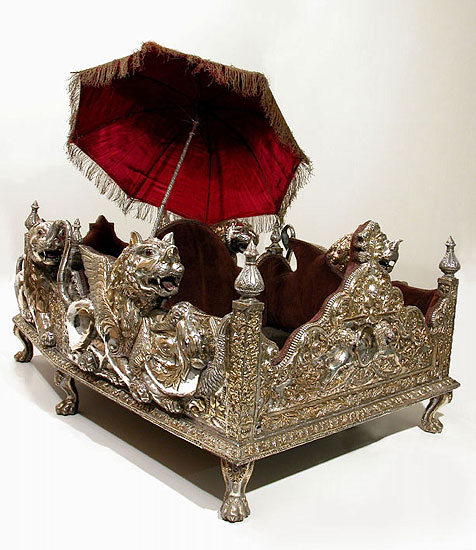|

Provenance: The Maharajah of Ambikaipur.
Silver, parcel-gilt, wood and velvet, amber, semi-precious stones and glass.
The body is composed of thin sheets of embossed silver pinned with numerous
nails to the wood carcass. Some of the thins strips around the borders are
stamped rather than embossed. The howdah is mounted on two iron bars that
run the length of the body and have iron rings attached to each end, to
which the harness would have been attached
Width 99 cm (39 in), length 150cm (59 in), height 74 cm (29 in).
This ostentatiously grand howdah is in the form of a small open carriage
divided into two seating compartments. The larger, forward-facing
compartments are designed for two passengers. Both the upper parts of the
front howdah and the backrests are surmounted by neogothic scrollwork and
pinnacles. The exterior of the howdah is of slightly convex profile and are
decorated with marvellously ornate repouss� work with motifs of lions,
mythical beasts and birds whose eyes are strikingly set with amber,
semi-precious stones, jet and glass. The side panels contain hunting scenes
depicting Indian Maharajas shooting animals and birds with muskets. The
decorative panels at the rear are chased with scrolling vines, ropework and
stylised foliage. The base of the howdah has shaped borders with chased
flowers on a herringbone ground.
This grand silver howdah, which was used on state occasions by the
Maharajahs and Maharenees of Ambikaipur, was designed for two passengers.
The word howdah is an Anglo-Indian term for the seat used for riding an
elephant. Symbols of status in the princely courts, they were ridden in
hunts, battles and on state and ceremonial occasions.
The profuse detailing of this howdah recalls the opulence manifested in the
princely courts in the period shortly before Queen Victoria was proclaimed
empress of India in 1877.
The companion howdah (for the Maharenee) is in the Asian Art Museum of San
Francisco, illustrated in Orientations, January 2003, cover. For a slightly
later (c.1880) and less richly decorated howdah, see T.B.Shroder, The
Gilbert Collection of Gold and Silver. Los Angeles County Museum of Art,
1988, p.648-649.
|